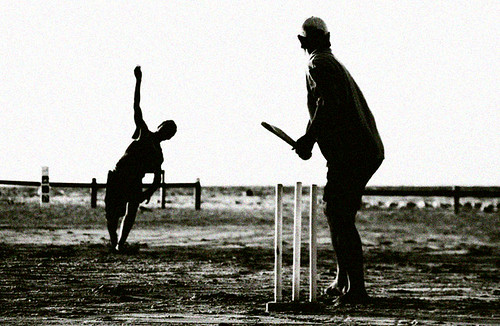
Somewhat bizarrely, when using Google to check its spelling, I came across an interesting Wikipedia definition for Howzat! (Another google related beginning in case anyone's keeping count!) And guess what happened when checking Hokey Cokey!!! I felt an irreverent reference to 'in-out, in-out, shake it all about' would reference a throw-away nursery rhythm, I didn't realise it had such a precise definition!
It's a strange world sometimes...
There's been a lot written, debated and ranted about in the media during the recent Test Series in the Caribbean regarding the use of technology in cricket. To such an extend in fact that the I.C.C.'s General Manager Dave Richardson flew over to the Windies to take a personal interest in the debate. I think regardless of the now cliched views that Cricket is the most appropriate sport to introduce technology, due to pace of the game, technical aspects of decision making blahdy blah... a lot of people have been missing the point in the debate. Like deploying technology in all other walks of life, its success depends solely on the understanding, ability and willingness of the people who are using the technology.

How the technology is used is another important factor, and one that was crucial during these trials. Back in 2004 when Hawkeye was first introduced, a lot of people were concerned with its impact on the game as it was merely a predication of where the ball could have hit the wickets. Lots and lots were written and debated back then, including this post from Buzzle.com. However over the years Hawkeye has almost become accepted as the rule, mainly because extensive studies have been done regarding its accuracy, and also because many people associated with the game began to realise that it was about on par with the human eye and judgement!
So having overcome the doubts seeing it become an integral part of the game, I think it a mistake not to make it available during the referral trials. The technology was introduced, field tested, proven but not accepted. It follows a worryingly similar pattern for a lot of technological developments that are placed in the hands of people who are not open minded and forward thinking.
The second part to the use of technology to determine the success of the trial centres on the understanding of how the umpires are going to use it. It was patently unclear, from first to last test, that this had not been well defined. Was the third umpire to use the technology and make a final decision, or were he to use the technology to ensure the on-field umpire had not made a mistake? We were left with the feeling that perhaps they did both!

In not clearly defining all parts of the trial well in advance, the I.C.C. failed to ensure maximum benefit was gained for the trial. Put the trial into a project context: the business case is clear. Players believe umpires make too many mistakes, and want to utilise technology to ensure a fairer decision making process. No problems there. The Risks? Integrity, Authority and technology's role within the game if it all went wrong are the main ones to spring to mind. Not catastrophic if managed correctly. Finally the objective? Provide fairer decision making utilising technology whilst maintaining the integrity of the game and authority of the on-field umpire. That's all fairly straight-forward stuff and shouldn't have caused too much consternation. So in a project context where did it go wrong? Not clearly defining the implementation. How the technology was to be used, how it wasn't, example processes for altering and upholding decisions. These aspects weren't clearly defined up front and the result was confusion.
I suspect from a purely human perspective, the third umpires also wanted to demonstrate their ability to make decisions with the aid of technology to increase the likely hood of a correct decision, so politics may also have played a part. Which leads into the main flaw in the plan: the people!
A trial is just that. Trying something to find out more. However even if it intended deployment is the Test arena, that wouldn't have been my first port of call to test. The unexpected outcomes of the trial (emergent properties, see I did listen sometimes during lectures!) need to be discovered away from spotlights and important platforms (such as test matches). For this trial they include the interpretation of the requirements when a decision is referred, ego (if I'm being particularly harsh!) and more telling perhaps, player despondency. The single emergent property that struck me was that no longer is an umpire's raised finger the end of a batsman. That is a huge unexpected shift in the game. In the first test, Gayle was out after a long innings. It was the breakthrough England needed. The finger went up. But then he wasn't out. And he went on, and on, and on! How that effects the bowler I don't know, but I can imagine!
In an ironic twist of events, the new referral system has the potential to be more conclusive and less divisive than the current umpire-based referrals. Utilising Hawkeye and Hot Spot in particular would at least give a quick, consistent and less debatable decision. The subjective use of technology to judge grounded catch is suddenly very primitive in comparison.
In short: there was nothing wrong with the technology that was used during the Test Series. The scope of technology used was debatable (limited without Hawkey, Hot Spot and the Snickometer), and the way in which the technology was used, flawed. The latter can be fixed with a little more thought and judgement, the former is easier still. No commotion, no debacle, no fuss. Just forward thinking technology enhancing the simple game of cricket. Easy.





